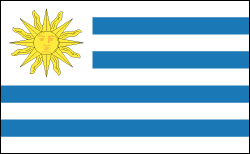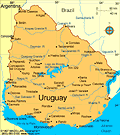Uruguay | Facts & Information

- Uruguay Profile
- History
- News and Current Events
Infoplease has everything you need to know about Uruguay. Check out our country profile, full of essential information about Uruguay's geography, history, government, economy, population, culture, religion and languages. If that's not enough, click over to our collection of world maps and flags.
Facts & Figures
-
President: Luis Alberto Lacalle Pou (2020)
Land area: 67,035 sq mi (173,621 sq km); total area: 68,039 sq mi (176,220 sq km)
Population (2022 est.): 3,407,21 (growth rate: 0.27%); birth rate: 12.71/1000; infant mortality rate: 8.31/1000; life expectancy: 78.43
Capital and largest city (2022 est.): Montevideo, 1.767 million
Monetary unit: Uruguay peso
Oriental Republic of Uruguay
National name: República Oriental del Uruguay
Languages: Spanish (official)
Ethnicity/race: White 87.7%, Black 4.6%, Indigenous 2.4%, other 0.3%, none or unspecified 5% (2011 est.)
Religions: Roman Catholic 42%, Protestant 15%, other 6%, agnostic 3%, atheist 10%, unspecified 24% (2014 est.)
Literacy rate: 98.8% (2019 est.)
Economic summary: GDP/PPP (2020 est.): $75.06 billion; per capita $21,600. Real growth rate: 2.7%. Inflation: 7.8%. Unemployment: 7.6%. Arable land: 10.1%. Agriculture: soybeans, rice, wheat; beef, dairy products; fish; lumber, cellulose. Labor force (2017 est.): 1.748 million; agriculture 13%, industry 14%, services 73%. Industries: food processing, electrical machinery, transportation equipment, petroleum products, textiles, chemicals, beverages. Natural resources: arable land, hydropower, minor minerals, fish. Exports: $13.55 billion (2020 est.): beef, soybeans, cellulose, rice, wheat, wood, dairy products; wool. Major trading partners (exports): China 29%, Brazil 12%, United States 5%, Netherlands 5%, Argentina 5% (2019). Imports: $11.29 billion (2020 est.): refined oil, crude oil, passenger and other transportation vehicles, vehicle parts, cellular phones. Major trading partners (imports): Brazil 25%, China 15%, United States 11%, Argentina 11% (2019).
Communications: Telephones: main lines in use: 1,224,600 (2020); mobile cellular: 4,779,790 (2019). Radio broadcast stations: more than 100 commercial radio stations and about 20 TV channels; cable TV is available; many community radio and TV stations; adopted the hybrid Japanese/Brazilian HDTV standard (ISDB-T) in December 2010 (2019). Internet Service Providers (ISPs): 1.036 million (2012). Internet users: 2,987,405 (2020).
Transportation: Railways: 1,673 km (2016) (operational; government claims overall length is 2,961 km). Highways: total: 77,732 km; paved: 7,743 km; unpaved: 69,989 km (2010 est.). Waterways: 1,600 km; used by coastal and shallow-draft river craft (2011). Ports and harbors: Colonia, Fray Bentos, Juan La Caze, La Paloma, Montevideo, Nueva Palmira, Paysandu, Punta del Este, Piriapolis. Airports: 133 (2021).
International disputes: in 2010, the ICJ ruled in favor of Uruguay's operation of two paper mills on the Uruguay River, which forms the border with Argentina; the two countries formed a joint pollution monitoring regime; uncontested boundary dispute between Brazil and Uruguay over Braziliera/Brasiliera Island in the Quarai/Cuareim River leaves the tripoint with Argentina in question; smuggling of firearms and narcotics continues to be an issue along the Uruguay-Brazil border.









